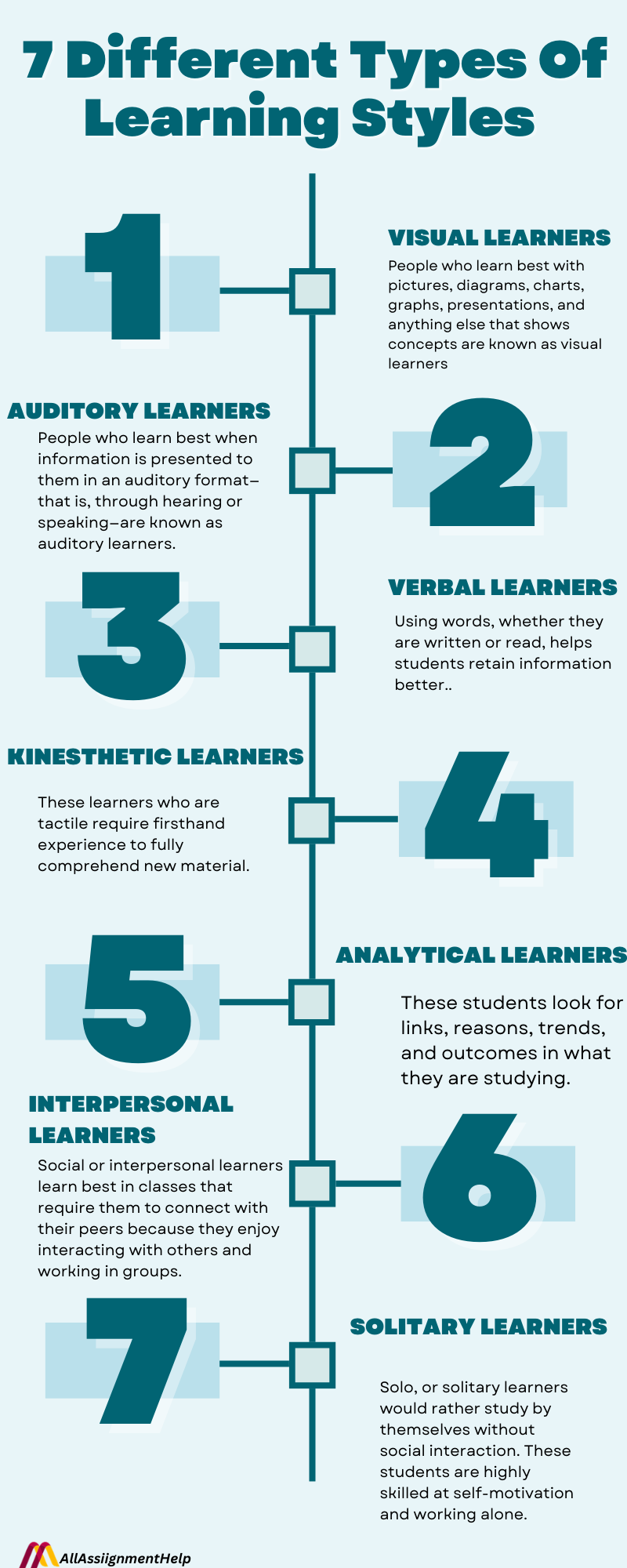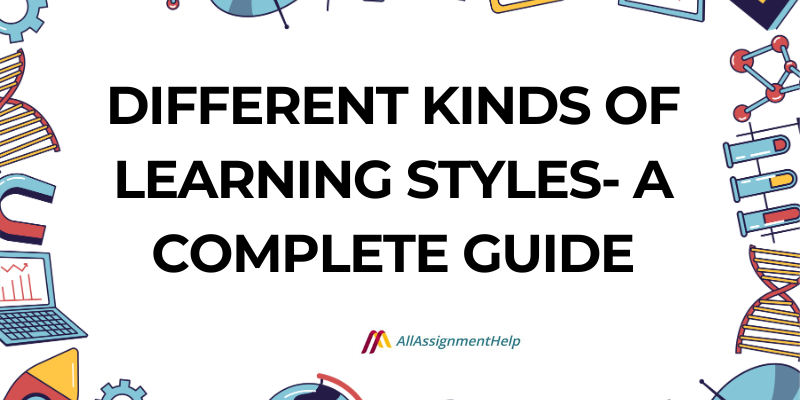Table of Contents
Every learner has a different approach to strengthen their ability to retain knowledge while studying. Some of them prefer to listen to lectures, while others take notes or draw diagrams. There is no one-size-fits-all learning method thus every student adopt different learning style according to their taste.
Each learning style explains the optimum way for a learner to take in, process, organize, and retain information. Today, most students even have numerous or overlapping learning styles, which is known as multimodal learning. Understanding the various learning styles is crucial for teachers since it will enable their students to capitalize on their strengths and improve their memory of what they are learning.
In this post of allassignmenthelp, we look at different learning styles and how to teach them.
What Do You Understand By Learning Styles?
Individuals’ preferred methods of absorbing, processing, and remembering information are referred to as learning styles. Learning types are based on the notion that each person has unique learning preferences and skills. Understanding and accounting for these individual variances can improve the effectiveness and personalization of education.
Designing courses that maximize learning for various individuals can be facilitated by an understanding of and application of these learning styles. Though, it’s crucial to remember, that the scientific community also has a critical opinion of the theory of learning types, especially when it comes to the data supporting its ability to enhance learning outcomes.
Students seeking additional academic support can opt for online assignment help services, which cater to a variety of learning needs. These services are widely available on platforms offering expert assistance across multiple subjects. Students can begin by researching reputable websites, reading reviews, and exploring the range of services offered, such as subject-specific help, customized solutions, or even step-by-step guidance on assignments.
What Are The Different Types Of Learning Styles In Education?
You may have come across the concept that individuals learn best through different methods, which is the foundation of the seven learning styles theory. This theory highlights unique strengths in each learning style, helping individuals retain information more effectively. Each style emphasizes either one of the five senses or a social element, making the approach highly adaptable. The popularity of this theory lies in the belief that identifying a learner’s preferred style and customizing teaching methods accordingly can enhance learning efficiency. The seven learning styles included in this theory are:

1. Visual learners
People who learn best with pictures, diagrams, charts, graphs, presentations, and anything else that shows concepts are known as visual learners. These individuals often draw and create other visual notes since it improves their memory.
Mind maps and colours work best for these students. They retain knowledge by using their visual memory for extended periods. Common characteristics of visual learners include constant planning and sketching, a strong attention span, keen observation, and a preference for visual instructions.
It’s not enough to just include pictures and infographics in your lessons when working with visual learners. The goal is to assist them in visualizing the connections between various bits of information or data as they acquire knowledge.
Teaching Strategies for Involving Visual Learners
- Make use of diagrams, maps, and images
- Incorporate technology such as projectors.
- Make use of color-coding strategies
- Promote flowcharts and mental maps
2. Auditory Learners/Auditory learning style
People who learn best when information is presented to them in an auditory format—that is, through hearing or speaking—are known as auditory learners. They are more likely to process their thoughts after speaking than to consider them carefully beforehand. Because they find that speaking aloud aids in their understanding of concepts.
Aural learners are generally quite good at explaining themselves and don’t hesitate to speak up. Remember that educating auditory learners shouldn’t involve them remaining silent for a long amount of time. Plan a few activities that allow you to ask questions and share thoughts. Learning new material will also be aided by watching videos or listening to audio during class.
Teaching Strategies for Involving Auditory Learners
- When reading the content, experiment with different tones and pitches.
- Record your vocal lessons.
- Promote group discussions, debates, and presentations in the classroom.
- Request that they instruct others orally.
3. Reading and writing (or verbal) learners
Using words, whether they are written or read, helps students retain information better. For verbal learners, written language is more potent and detailed than spoken language or pictures, which is why they excel at writing novels, articles, essays, and other written works.
They believe that word has a greater impact than any type of visual or aural depiction of a concept. These people usually excel in written work. Their vocabulary is usually extensive, and they may even like using techniques like acronyms, rhymes, and tongue twisters. It has been proven that verbal learners love to read.
Teaching Strategies to interact with verbal learners
- Use mnemonics (song, rhyme, acronym, phrase) when instructing.
- Instill scripts
- Students should be encouraged to write down and express their thoughts.
- Add crossword and other word games.
If you’re a verbal learner enrolled in online courses and finding it challenging to manage time or balance multiple tasks, seeking assistance with your coursework can be a practical solution. Services that offer support for queries such as can someone do my online course for me, enable you to delegate responsibilities to experienced professionals. These experts provide detailed notes, comprehensive written materials, and personalized guidance tailored to your learning style. This approach helps you stay on track, deepen your understanding of the subject, and manage your commitments more effectively.
4. Kinesthetic Learners
Kinesthetic learners take in information through a variety of senses. Their preferred method of learning is experiential or hands-on. These learners who are tactile require firsthand experience in order to fully comprehend new material. Because of this, getting ready for them in a conventional educational context can be a little difficult.
A hands-on experience is enjoyable to them. They need to use tactile experience to better understand things because they are typically more linked to and in touch with reality.
Personal experience, practice, examples, or simulations are the most effective ways to introduce new material to a kinesthetic learner.
However, kinesthetic learners often face challenges when adapting to online assessments, which are usually less interactive. In such cases, seeking support through online services can bridge the gap. Yes, these learners can approach the expert by saying, take my online exam for me. These services not only manage exam-related stress but also offer tailored solutions that align with a kinesthetic learner’s needs. By providing detailed walkthroughs or step-by-step problem-solving approaches, such services ensure that even in a virtual setting, kinesthetic learners can engage effectively with the material and achieve academic success.
5. Logical/analytical learners
Analytical learners rely on reasoning and critical thinking to comprehend a given topic. These students look for links, reasons, trends, and outcomes in what they are studying. A teacher can use materials that stimulate problem-solving abilities, ask questions that need interpretation, and encourage students to draw conclusions based on logic or facts in order to engage and motivate these pupils.
Teaching Strategies for Involving Logical Learners
- Make your lessons’ system simple to use.
- Make an effort to incorporate statistics into disciplines outside of mathematics.
- Sort ideas into categories or groups.
- Create cause-and-effect links between variables for every topic.
Read Also: How to Write My Mother Essay in 500 Words?
6. Interpersonal learners
Social or interpersonal learners learn best in classes that require them to connect with their peers because they enjoy interacting with others and working in groups. Consider class tests, study groups, and peer conversations.
These students like learning activities that involve group projects or participation. Social and linguistic learners gain two benefits from this involvement: a deeper comprehension of a subject and the opportunity to socialize, which they enjoy. Role-playing and various communication exercises, such as promoting student interaction (asking questions, sharing experiences, etc.), are two ways that teachers might inspire these kinds of students.
Teaching Strategies for interacting with lone learners
- Determine their preferred method of learning and implement those techniques.
- Choose a peaceful location.
- Periodically check in with them and establish a time for cooperation so they feel well-prepared.
7. Solitary Learners
Solo, or solitary learners would rather study by themselves without social interaction. These students are highly skilled at self-motivation and working alone. On the other hand, they typically struggle with group debates and teamwork.
They are more self-reliant and reflective, and they prefer to stay alone with their ideas and thoughts free from excessive outside influence. These types typically sit in the back of the class or are referred to as the “quiet kids,” but they might do well on the test. Other learning styles may also be close to solitary learning.
Teaching Strategies for interacting with lone learners
- Determine their preferred method of learning and implement those techniques.
- Choose a peaceful location.
- Communicate with them periodically.
- Establish a precise time for cooperation so they feel adequately equipped.
Thus, keep in mind that everyone has different styles of learning, not every learning style will be suited for everyone thus study tips for different learners should also be different. Students are not required to be one type of learner, and this is probably not the case. Their learning methods can be found in a variety of mixes and variants. Another name for this strategy is a multimodal one. Statistics show that over 60% of people learn in multiple ways.
Recognize that each student is unique and that you may need to look for alternative approaches to their schooling. Again, the subject matter may also be the source of these discrepancies. Others may have entirely different interests, while some are more interested in and suited to others. These learning types merely give you a general framework to work inside. For instance, students who struggle with writing tasks may need a focused approach, especially in challenging subjects like English. Seeking English assignment help can provide the personalized guidance they need to bridge gaps in their understanding, tailor their learning strategies, and achieve academic success. These learning styles are a flexible framework for adapting teaching methods to diverse needs.
Read Also: How Foreign Education Affects the Economy of the USA
FAQs
| Can a person have multiple learning styles? Yes, most people use a mix of learning styles, known as multimodal learning, to process and retain information effectively. |
| Do learning styles impact academic performance? While they provide a framework for teaching, it’s important to recognize that learning styles alone may not determine academic outcomes. Teaching strategies should be flexible to suit individual needs. |
| How can services like assignments help assist students? Assignment help provides personalized guidance, support with writing tasks, and strategies to improve comprehension and performance in related assignments. |
